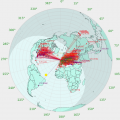G8JNJ
About
- Username
- G8JNJ
- Joined
- Visits
- 3,965
- Last Active
- Roles
- Member
- Points
- 53
Reactions
-
Wellgood balanced loop amplifier, (Wellbrook clone).
Hi John,
Build the LZ1AQ instead.
It's a better performer and easier to construct, plus I'm not 100% convinced about George's reverse engineered circuit, especially the transformer windings and specifically the configuration on the binocular core. Norton amplifiers bring about lots of other problems and after playing with a lot of different designs, I'm not sure they are worth the effort.
My initial IMD measurements were constrained by my test setup, with my better test rig I measure
LZ1AQ OIP2 +79dBm OIP3+36dBm
Wellgood OIP2 +57dBm OIP3+37dBm (note that the Wellgood is based on an early Wellbrook design and the new ones are better)
The overall performance of all loops, especially on the HF bands is determined by loop size and inductance and amplifier input impedance. This is why most loops 'run out of steam' above about 10MHz.
I've found that contrary to most wisdom, if you can't build a nice 'fat' low inductance loop, it would seem to be better to use an amplifier with a higher value of input impedance (tens of Ohms), in order to improve performance on the HF bands (where the loop inductive reactance dominates the feed point impedance), and compromise a bit on the LF bands, where the natural noise floor tends to be a lot higher (particularly in urban areas) and the very strong Broadcast Stations tend to be problematic anyway.
Some more info on my Active antennas web page
https://www.g8jnj.net/activeantennas.htm
Here's a link I found to a lot of Clifton Labs Norton amplifier circuits (grab them while you can) that may be of interest to you and others on here (use Google translate)
https://www.okdxf.eu/index.php/technika/262-manualy-konstrukci-clifton-laboratories-k8zoa
Interestingly for some reason they also produced a higher gain amplifier using four Gali-74's the Z10046A, but I still haven't been able to track down a circuit of the amplifier they produced for the Pixel Loop now sold by DX Engineering (they have withdrawn all Clifton Labs on-line circuit diagrams since they bought them) as the RF-PRO-1B
https://www.dxengineering.com/parts/dxe-rf-pro-1b
Send me a private message if you wish.
Regards,
Martin - G8JNJ -
QRM: Radio China International - From Albania - OV +++
Hi Giulio,
Adding a series tuned notch filter across the KiWi RF input will help reduce the problems on 7345KHz.
These values give the bets compromise between notch depth and attenuation on the adjacent 40m amateur band.
For this simulation I have used an inductor with a Q of 50. But if you can use a better inductor, it will provide a deeper and narrower notch.
31 turns wound on a T50-2 iron powder core would be a good starting point, but you would have to add or remove turns in order to tune the notch to the exact frequency.
It will attenuate signals on 40m to a certain extent, so the signal levels will drop slightly, however as the natural noise floor is usually the limiting factor on the lower frequency bands, I don't think it will harm the Signal to Noise ratio.
As a test you could run the WSPR decoder with and without the notch in circuit, and compare the average S/N before and after, but always compare reports of the same transmitting stations, don't compare different stations with each other.
The other interference is something local to you, but sort out the 7MHz overload before investigating the other problems.
Regards,
Martin - G8JNJ -
Last Spectrum persists when all signals removed [fixed in v1.279]
-
On-Line frequency database
Copied from UDXF@groups.io
"You may or may not be aware that the ITU monitoring stations publish their
listening logs on their public website:
https://www.itu.int/en/ITU-R/terrestrial/monitoring/Pages/Regular.aspx
This page describes the purpose of the monitoring activity as well as
allowing you to download the logs as Excel spreadsheets; there's also a
search tool so you can search for logs by frequency and date.
The spreadsheets often include DF bearings with an accuracy indication and
signal strength as well as time, frequency, mode, comments etc.
They often mention the kind of things we like listening to!"
I've previously taken a look at the ITU loggings but they always tended to be a bit of a pin to trawl through.
However the new database search tool is very good. Especially if you are careful about what search parameters you set. You can then click on a individual log entry for even more detail.
It would be even better if you could download the searched results, but maybe someone will get around to writing a scraper tool :-)
Regards,
Martin - G8JNJ -
Ethernet filters
Hi All,
I see that DX Engineering are now offering Ethernet filters.
https://www.dxengineering.com/parts/dxe-iso-plus-2
"DX Engineering ISO-PLUS Ethernet RF Filters are very effective EMI Suppressors that are quickly and easily connected inline on Cat5e or Cat6 network cables. Their patent pending design provides common mode RF interference and EMI noise filtering of radio frequencies from well below 1 MHz to over 100 MHz. DX Engineering ISO-PLUS Ethernet RF Filters are bidirectional (input and output is interchangeable) and they have no effect on digital throughput; Ethernet data signal levels and speed remain unchanged."
Regards,
Martin - G8JNJ







